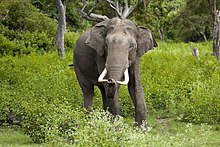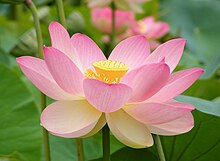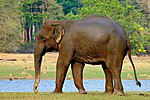J u m p t o c o n t e n t
M a i n m e n u
M a i n m e n u
N a v i g a t i o n
● M a i n p a g e ● C o n t e n t s ● C u r r e n t e v e n t s ● R a n d o m a r t i c l e ● A b o u t W i k i p e d i a ● C o n t a c t u s ● D o n a t e
C o n t r i b u t e
● H e l p ● L e a r n t o e d i t ● C o m m u n i t y p o r t a l ● R e c e n t c h a n g e s ● U p l o a d f i l e
S e a r c h
Search
A p p e a r a n c e
● C r e a t e a c c o u n t ● L o g i n
P e r s o n a l t o o l s
● C r e a t e a c c o u n t ● L o g i n
P a g e s f o r l o g g e d o u t e d i t o r s l e a r n m o r e ● C o n t r i b u t i o n s ● T a l k
( T o p )
1 F a u n a
2 F l o r a
3 C o n s e r v a t i o n
4 N a t i o n a l s y m b o l s
5 S e e a l s o
6 R e f e r e n c e s
7 F u r t h e r r e a d i n g
8 E x t e r n a l l i n k s
T o g g l e t h e t a b l e o f c o n t e n t s
W i l d l i f e o f I n d i a
7 l a n g u a g e s
● ব া ং ল া ● भ ो ज प ु र ी ● ف ا ر س ی ● ह ि न ् द ी ● I t a l i a n o ● த ம ி ழ ் ● ไ ท ย
E d i t l i n k s
● A r t i c l e ● T a l k
E n g l i s h
● R e a d ● E d i t ● V i e w h i s t o r y
T o o l s
T o o l s
A c t i o n s
● R e a d ● E d i t ● V i e w h i s t o r y
G e n e r a l
● W h a t l i n k s h e r e ● R e l a t e d c h a n g e s ● U p l o a d f i l e ● S p e c i a l p a g e s ● P e r m a n e n t l i n k ● P a g e i n f o r m a t i o n ● C i t e t h i s p a g e ● G e t s h o r t e n e d U R L ● D o w n l o a d Q R c o d e ● W i k i d a t a i t e m
P r i n t / e x p o r t
● D o w n l o a d a s P D F ● P r i n t a b l e v e r s i o n
A p p e a r a n c e
F r o m W i k i p e d i a , t h e f r e e e n c y c l o p e d i a
India is one of the most biodiverse regions and is home to a large variety of wildlife. It is one of the 17 megadiverse countries and includes three of the world's 36 biodiversity hotspots – the Western Ghats , the Eastern Himalayas , and the Indo-Burma hotspot.[1] [2]
About 24.6% of the total land area is covered by forests. It has various ecosystems ranging from the high altitude Himalayas , tropical evergreen forests along the Western Ghats, desert in the north-west, coastal plains and mangroves along the peninsular region. India lies within the Indomalayan realm and is home to about 7.6% of mammal , 14.7% of amphibian , 6% of bird , 6.2% of reptilian , and 6.2% of flowering plant species.
Human encroachment, deforestation and poaching are significant challenges that threaten the existence of certain fauna and flora. Government of India established a system of national parks and protected areas in 1935, which have been subsequently expanded to nearly 1022 protected areas by 2023. India has enacted the Wildlife Protection Act of 1972 and special projects such as Project Tiger , Project Elephant and Project Dolphin for protection of critical species.
Indian elephant , the largest animal species in India
India has an estimated 92,873 species of fauna, roughly about 7.5% of the species available worldwide.[3] [4] mammals , 1233 birds , 526 reptiles , 342 amphibians , 3022 fish apart from other species which form 7.6% of mammal, 14.7% of amphibian, 6% of bird, 6.2% of reptilian species worldwide.[3] [5]
Many Indian species are descendants of species originating in Gondwana , of which India originally was a part. Peninsular India 's subsequent movement towards, and collision with, the Laurasian landmass set off a mass exchange of species. However, volcanism in the Deccan Traps and climatic change 20 million years ago caused the extinction of many endemic Indian forms.[6] zoogeographical passes on either side of the emerging Himalayas.[7] [5]
India is home to several well-known large animals, including the Indian elephant ,[8] Indian rhinoceros ,[9] Gaur .[4] big cats tiger and lion exist in the wild. Members of the cat family include Bengal tiger ,[10] Asiatic lion ,[11] Indian leopard ,[12] snow leopard ,[13] clouded leopard .[14] blackbuck , nilgai , [bharal]], barasingha , Nilgiri tahr , and Nilgiri langur .[4]
There are about 31 species of aquatic mammals including dolphins , whales , porpoises , and dugong .[15] gharial , the only living members of Gavialis and saltwater crocodiles .[4] peafowl , pheasants , geese , ducks , mynas , parakeets , pigeons , cranes , hornbills , and sunbirds .[4] great Indian hornbill , great Indian bustard , nicobar pigeon , ruddy shelduck , Himalayan monal , and Himalayan quail .[16] [17]
Lotus , the national flower of India
About 24.6% of the total land area is covered by forests.[18] ecoregions ranging from the high altitude Himalayas , tropical evergreen forests along the Western Ghats, desert in the north-west, coastal plains and mangroves along the peninsular region.[19]
There are about 29,015 species of plants including 17,926 species of flowering plants . This is about 9.1% of the total plant species identified worldwide and 6,842 species are endemic to India. Other plant species include 7,244 algae , 2,504 bryophytes , 1,267 pteridophytes and 74 gymnosperms .[3] [20] [21]
Conservation [ edit ]
India harbors 172 (2.9%) IUCN -designated threatened species.[22] mammals , 72 species of birds , 17 species of reptiles , three species of amphibians , two species of fish , and a number of insects including butterflies , moths , and beetles .[4] [23]
Human encroachment, deforestation and poaching are significant challenges that threaten the existence of certain fauna and flora. Government of India established a system of national parks and protected areas in 1935, which have been subsequently expanded to nearly 1022 protected areas by 2023. Various laws have been enacted such as Indian Forest Act, 1927 and Wildlife Protection Act of 1972 and special projects such as Project Tiger , Project Elephant and Project Dolphin have been initiated for the protection of forests, wildlife and critical species.[7] [24]
As of 2023, there are 1022 protected areas including 106 national parks , 573 wildlife sanctuaries , 220 conservation reserves and 123 community reserves. In addition, there are 55 tiger reserves, 18 biosphere reserves and 32 elephant reserves.[18]
National symbols [ edit ]
See also [ edit ]
References [ edit ]
^ a b c "List of Species" . Government of India . Retrieved 1 December 2023 .
^ a b c d e f "Fauna of India" . Government of India . Retrieved 1 December 2023 .
^ a b Biodiversity profile for India (Report). United Nations Environmental Programme (UNEP), World Conservation Monitoring Centre. Retrieved 1 December 2023 .
^ K. Praveen Karach. (2006). Out-of-India Gondwanan origin of some tropical Asian biota (PDF) (Report).
^ a b Tritsch, M.E. (2001). Wildlife of India . London: Harper Collins. ISBN 0-00-711062-6
^ Baskaran, N. & Desai, A. A. (1996). "Ranging behaviour of the Asian elephant (Elephas maximus ) in the Nilgiri Biosphere Reserve, South India" (PDF) . SSC Asian Elephant Specialist Group . 15
^ Choudhury, A. U. (1985). "Distribution of Indian one-horned rhinoceros" . Tiger Paper . 12 2 ): 25–30.
^ Jhala, Y. V.; Qureshi, Q.; Nayak, A. K. (2019). Status of tigers, co-predators and prey in India 2018. Summary Report. TR No./2019/05 . New Delhi, Dehradun: National Tiger Conservation Authority & Wildlife Institute of India.
^ Singh, H. S. & Gibson, L. (2011). "A conservation success story in the otherwise dire megafauna extinction crisis: The Asiatic lion (Panthera leo persica ) of Gir forest" (PDF) . Biological Conservation . 144 (5 ): 1753–1757. doi :10.1016/j.biocon.2011.02.009 .
^ Mondal, K.; Gupta, S.; Bhattacharjee, S.; Qureshi, Q. & K. Sankar (2012). "Prey selection, food habits and dietary overlap between leopard Panthera pardus (Mammalia: Carnivora) and re-introduced tiger Panthera tigris (Mammalia: Carnivora) in a semi-arid forest of Sariska Tiger Reserve, Western India" . Italian Journal of Zoology . 79 4 ): 607–616. doi :10.1080/11250003.2012.687402
^ Mishra, C. (1997). "Livestock depredation by large carnivores in the Indian trans-Himalaya: conflict perceptions and conservation prospects" (PDF) . Environmental Conservation . 24 4 ): 338–343. doi :10.1017/S0376892997000441 .
^ Choudhury, A. U. (1992). "The Clouded Leopard in Assam" . Oryx . 27 1 ): 51–53. doi :10.1017/s0030605300023966
^ Aquatic mammals of India (PDF) (Report). Marine Biology Regional Centre, Zoological Survey of India. 2011. Retrieved 1 December 2023 .
^ "7 Rare and Exotic Wildlife Species that can be found in India" . 19 June 2015.
^ "Animals in Indian Sub-Continent" . Archived from the original on 2 March 2022.
^ a b "Protected areas" . Government of India . Retrieved 1 December 2023 .
^ "Eco-regions of India" . Ecoregion restoration alliance . Retrieved 1 December 2023 .
^ Manoharachary, C.; Sridhar, K.; Singh, R.; Adholeya, A.; Suryanarayanan, T. S.; Rawat, S. & Johri, B.N. (2005). "Fungal biodiversity: Distribution, conservation and prospecting of fungi from India" (PDF) . Current Science . 89 1 ). Archived from the original (PDF) on 28 August 2017.
^ Fungal biodiversity: Distribution, conservation and prospecting of fungi from India (Report). Retrieved 1 December 2023 .
^ Groombridge, B. (1993). The 1994 IUCN Red List of Threatened Animals (Report). IUCN. p. 286.
^ "India's bird populations 'declining sharply', research shows" . 18 February 2020. Retrieved 1 December 2023 .
^ Singh, M. P.; Singh, J. K.; Mohanka, R. (2007). Forest Environment and Biodiversity ISBN 9788170354215
^ a b "National symbols" . Government of India . Retrieved 1 December 2023 .
^ a b c "National symbols of India" . Government of India . Retrieved 1 December 2023 .
^ "Dolphin becomes India's national aquatic animal" . Archived from the original on 8 October 2009.
^ a b "Significant symbols" . The Hindu . Retrieved 1 December 2023 .
Further reading [ edit ]
Saravanan, Velayutham. Environmental History of Modern India: Land, Population, Technology and Development (Bloomsbury Publishing India, 2022) online review
Prasad, S.N.; Ramachanandra, T.V.; Ahalya, N.; Sengupta, T.; Kumar, A.; Tiwari, A.K.; Vijayan, V.S. & Vijayan, L. (2002). "Conservation of wetlands of India – a review" . Tropical Ecology . 43 1 ): 173–186. CiteSeerX 10.1.1.526.3559
Manoharachary, C.; Sridhar, K.; Singh, R.; Adholeya, A.; Suryanarayanan, T. S.; Rawat, S. & Johri, B.N. (2005). "Fungal biodiversity: Distribution, conservation and prospecting of fungi from India" (PDF) . Current Science . 89 1 ). Archived from the original (PDF) on 28 August 2017.
Jamaluddin, M.G.; Goswami; B.M. Ojha (2004). Fungi of India 1989–2001 . Scientific Publishers. ISBN 8172333544
External links [ edit ]
Official website of: Government of India, Ministry of Environment & Forests
"Legislations on Environment, Forests, and Wildlife" from the Official website of: Government of India, Ministry of Environment & Forests
"India's Forest Conservation Legislation: Acts, Rules, Guidelines", from the official website of the Government of India, Ministry of Environment & Forests
Wildlife Legislations, including - "The Indian Wildlife (Protection) Act" from the Official website of: Government of India, Ministry of Environment & Forests
R e t r i e v e d f r o m " https://en.wikipedia.org/w/index.php?title=Wildlife_of_India&oldid=1223915650 " C a t e g o r i e s : ● W i l d l i f e o f I n d i a ● W i l d l i f e b y c o u n t r y ● B i o t a o f I n d i a H i d d e n c a t e g o r i e s : ● A r t i c l e s w i t h s h o r t d e s c r i p t i o n ● S h o r t d e s c r i p t i o n i s d i f f e r e n t f r o m W i k i d a t a ● U s e d m y d a t e s f r o m J a n u a r y 2 0 1 6 ● U s e I n d i a n E n g l i s h f r o m J u n e 2 0 1 6 ● A l l W i k i p e d i a a r t i c l e s w r i t t e n i n I n d i a n E n g l i s h
● T h i s p a g e w a s l a s t e d i t e d o n 1 5 M a y 2 0 2 4 , a t 0 4 : 1 6 ( U T C ) . ● T e x t i s a v a i l a b l e u n d e r t h e C r e a t i v e C o m m o n s A t t r i b u t i o n - S h a r e A l i k e L i c e n s e 4 . 0 ;
a d d i t i o n a l t e r m s m a y a p p l y . B y u s i n g t h i s s i t e , y o u a g r e e t o t h e T e r m s o f U s e a n d P r i v a c y P o l i c y . W i k i p e d i a ® i s a r e g i s t e r e d t r a d e m a r k o f t h e W i k i m e d i a F o u n d a t i o n , I n c . , a n o n - p r o f i t o r g a n i z a t i o n . ● P r i v a c y p o l i c y ● A b o u t W i k i p e d i a ● D i s c l a i m e r s ● C o n t a c t W i k i p e d i a ● C o d e o f C o n d u c t ● D e v e l o p e r s ● S t a t i s t i c s ● C o o k i e s t a t e m e n t ● M o b i l e v i e w












